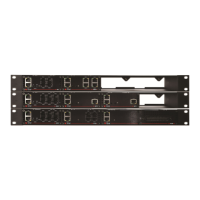QX50/QX200/QX2000; (SW Version 6.0.x) 84
QX50/QX200/QX2000 Manual II: Administrator’s Guide
• None configures the system to send ALERT messages without the Progress Indicator information element (IE).
• Unconditional configures the system to send ALERT/PROGRESS messages with the Progress Indicator IE. With this option, the system will send its
own progress tone.
• Conditional configures the system to send ALERT/PROGRESS messages with Progress Indicator IE. With this option, the system will send its own
progress tone only if there is no early media (180/183 with SDP) from the called party.
Incoming Called Digits Size text field indicates the number of received digits (in a range from 0 to 255) required to establish a call. When field has 0
value, system uses either timeout defined in the T302 field or the Sending Complete Information element messages to establish a call. Independent on
the value in this field, Sending Complete Information element and pound sign always cause the call establishment.
The Generate Progress tone on IP checkbox selection will generate the progress tone to IP (SIP).
If the Send ALERT Message on Call Ringing checkbox is selected, the system will send ALERT messages to callers from the PSTN/PBX on call ringing. If
not, the system will send a PROGRESS message on receiving early media from the called party if the Generate Progress Tone to PSTN/PBX setting is not
set to None.
Enable CLIR Service checkbox selection enables Calling Line Identification Restriction (CLIR) service which displays the incoming caller ID only in case if
Presentation Indication is allowed on the remote side. Otherwise, if CLIR service is disabled, caller ID will be unconditionally displayed.
When the Enable Connect Acknowledge Option checkbox is selected, QX will stop the T303 and T310 timers upon receiving the CONNECT message, will
send a CONNECT ACKNOWLEDGE message to the remote side and enter the active state. When this checkbox is not selected, QX will stop the T303 and
T310 timers upon receiving the CONNECT message and will enter the active state without sending the CONNECT ACKNOWLEDGE message to the remote
side.
P-Asserted-Identity:
The Disable P-Asserted-Identity radio button disables the P-Asserted-Identity feature for both incoming and outgoing calls.
The Override CLID with P-Asserted-Identity radio button selection enables the SIP P-Asserted-Identity support.
For the calls from SIP to E1/T1 if the Invite SIP message contains a P-Asserted-Identity or a P-Preferred-Identity or a Remote-Party-ID, then the CallerID
on E1/T1 is sent with the original Caller ID which comes from the identity field. SIP user agent should check for the existence of the P-Asserted-Identity,
then the P-Preferred-Identity, then the Remote-Party-ID to fill the identity field.
For the calls from E1/T1 to SIP with restricted Caller ID, the SIP Invite message contains P-Asserted-Identity field with the value from the Caller ID on
E1/T1. The SIP From field contains anonymous.
The Use Redirecting Number Info Element with P-Asserted-Identity radio button selection enables full support of the SIP P-Asserted-Identity.
For the calls from SIP to E1/T1, if the SIP Invite message contains a P-Asserted-Identity or a P-Preferred-Identity or a Remote-Party-ID, then the CallerID
on E1/T1 contains the number from the user name field and the Redirecting Number IE contains the original number from the identity field. SIP user
agent should check for the existence of the P-Asserted-Identity, then the P-Preferred-Identity, then the Remote-Party-ID to fill the identity field.
For the calls from E1/T1 to SIP with Caller ID, the SIP Invite message contains P-Asserted-Identity field with the original number value from the
Redirecting Number IE on E1/T1. The SIP From field contains the value from the user name.
The E1/T1 Stats are not available in shared mode.
Incoming Interdigit Service
Incoming Interdigit Service
is used to configure E1/T1 dial
plan for the incoming calls from CO/PBX to the QX. This service
allows you to speed up the call establishment procedure by
detecting the prefix. The calls will be speed up by the timeout
defined in the Incoming Digits Timeout text field.
When the system detects incoming dialed number starting with any
of the prefixes listed in the Incoming Interdigit Service table, it will
wait for the rest of the digits, as specified for the corresponding
prefix in the Incoming DNIS Size text field (see below). Once all
digits are received, the system will route the call to the destination.
The Incoming Interdigit Service page lists a table with existing
E1/T1 dial plan entries and allows you to manage them.
By default, the table on the Incoming Interdigit Service page lists
the locale specific (selected from the
System Configuration Wizard)
E1/T1 dial plan settings. For some countries, this table may however
be empty.
Fig.II- 124: Incoming Interdigit Service page





